Understanding and Utilizing the Zig Zag Indicator on TradingView
Technical analysis forms the backbone of many traders’ strategies, offering insights into market trends and potential price movements. Among the plethora of tools available, the Zig Zag indicator stands out as a key instrument for identifying significant trends while filtering out market noise.
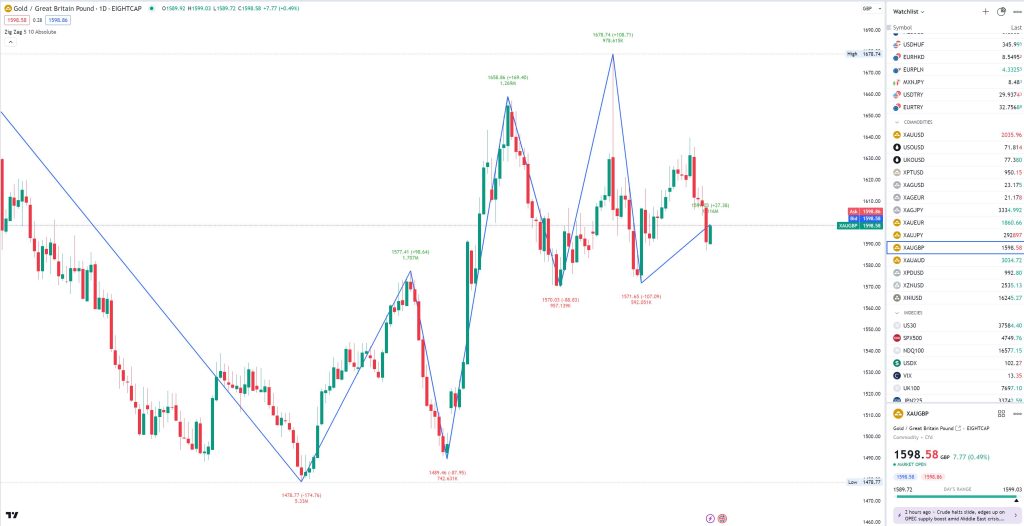
What is the Zig Zag Indicator?
The Zig Zag indicator is a technical tool designed to assist traders in recognizing essential trends within a price chart. It is generally used to identify price trends, and in doing so plots points on the chart to mark whenever prices reverse by a larger percentage point than a predetermined variable or marker. The points are connected by straight lines that help the trader visualise the price action. Its primary function involves smoothing out fluctuations below a set threshold, providing a clearer visual representation of market movements. By focusing on significant price changes, the indicator helps traders discern pivotal moments in a security’s price action.
By filtering out small price movements, the Zig Zag indicator can keep the trader’s focus on trends and their direction. The Zig Zag indicator is great for highlighting trend direction and lowering noise levels. It works best with strong, trending markets. The Zig Zag indicator doesn’t assess or predict future trends, however, it does help identify and plot swing highs and swing lows.
Traders should pay attention to this key point: Zig Zag lines aren’t always permanent. When there’s a price reversal, the indicator generates a new line. If this new line doesn’t meet the indicator’s defined percentage setting and the price changes direction, the chart replaces the line with an extended Zig Zag line aligning with the original trend.
Some traders utilize this indicator to confirm trend direction and assess strength or weakness, rather than aiming for flawless entry or exit points. However, this reliance comes with limitations as the readings are never entirely accurate. This impacts the indicator’s interpretation, prompting traders to consider using the Zig Zag indicator alongside other trend-following indicators for more precise and profitable trading outcomes.
Calculation and definitions
Calculations
The Zig Zag indicator can be calculated with the following formula:
ZigZag (HL, % change = X , retrace = FALSE, LastExtreme = TRUE) If % change > = X, plot ZigZag
Definitions
HL stands for either the High-Low price series or the Closing price series.
% change denotes the minimum price movement represented as a percentage.
Retrace signifies the alteration in the retracement of a prior movement or an absolute change from the highest to the lowest point.
LastExtreme refers to the extreme price, typically observed consistently across multiple periods (often the initial or final price recorded).
To compute the Zig Zag indicator, follow these steps:
Commence by selecting a starting point, which could be a swing high or swing low. Subsequently, define the % price movement.
Identify the next swing—another swing high or low—that differs from your initial starting point.
Create a trendline linking the starting point to this new swing.
Once again, pinpoint the subsequent swing high or low, ensuring it differs from the point established in Step 3.
Draw a fresh trendline connecting these new points. Repeat these steps for each subsequent swing high or low.
Key Features and Settings
TradingView offers traders the flexibility to customize the Zig Zag indicator to suit their specific trading preferences. Users can adjust parameters such as percentage or point changes, depth, and deviations. These customizable settings enable traders to adapt the indicator to varying market conditions and align it with their trading strategies.
1. Percentage or Point Changes:
- TradingView allows users to define the minimum price change required for a new trend line to be plotted. This can be set as a percentage or a fixed point value.
- Percentage changes are often used for more dynamic markets, while fixed point changes may suit assets with lower volatility.
2. Depth (Pivot legs):
- The depth parameter determines the minimum number of candles required to form a swing high or swing low. This setting filters out minor fluctuations, emphasizing more significant price movements.
- Traders can adjust the depth to accommodate various timeframes, with higher values smoothing out trends over longer periods and lower values capturing shorter-term movements.
3. Deviations:
- Deviations play a crucial role in the indicator’s sensitivity to price movements. Higher deviation settings filter out smaller price swings, focusing only on more substantial price changes.
- Lower deviations make the indicator more sensitive, capturing smaller price fluctuations that might be overlooked with higher settings.
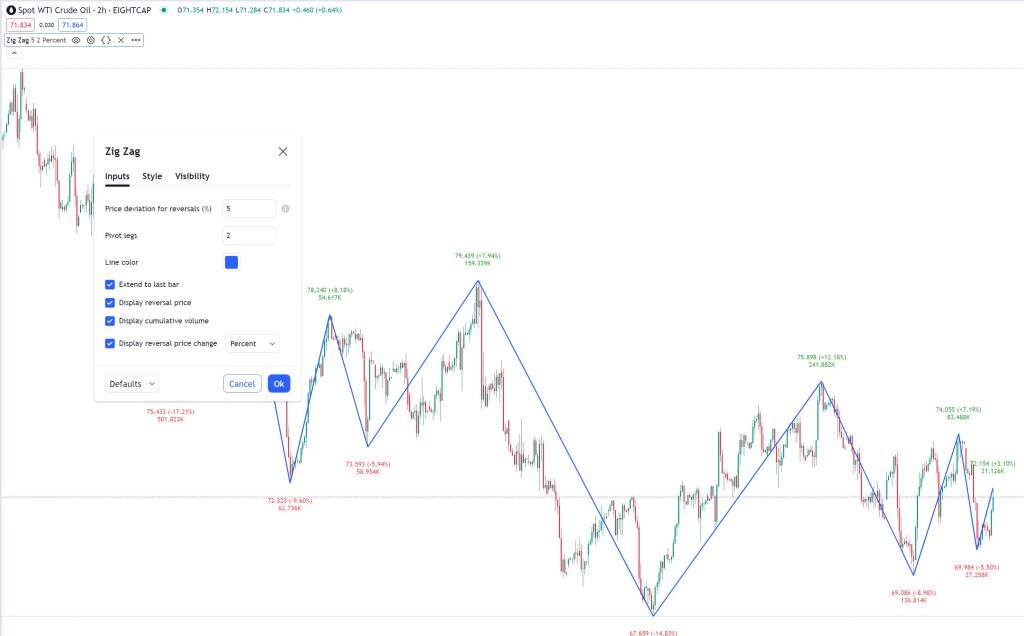
4. Customization for Market Conditions:
- The adaptability of the Zig Zag indicator’s settings allows traders to tailor its behavior to different market conditions. For instance, in a volatile market, adjusting parameters to be more sensitive might provide better insights into short-term price movements.
- In contrast, during stable market conditions, using higher settings could help in identifying long-term trends while disregarding minor fluctuations.
5. Visual Clarity and Interpretation:
- Adjusting the settings not only affects how the Zig Zag indicator appears on the chart but also influences how traders interpret the trends. Finding the right balance between sensitivity and noise reduction is key to effective use.
- Visual clarity can assist traders in easily identifying trend changes and potential reversal points, enhancing the overall decision-making process.
Using the Zig Zag Indicator in Trading
One of the primary utilities of the Zig Zag indicator lies in identifying trends and potential trend reversals. By pinpointing key turning points in the price chart, traders can anticipate shifts in market sentiment. This tool aids in clarifying the direction of the trend, enabling traders to make more informed decisions about entry and exit points.
1. Trend Identification:
- The Zig Zag indicator excels in highlighting major price movements while filtering out insignificant fluctuations. Traders use it to identify the direction of the prevailing trend.
- During an uptrend, the Zig Zag indicator plots higher swing highs and higher swing lows. Conversely, in a downtrend, it reveals lower swing highs and lower swing lows.
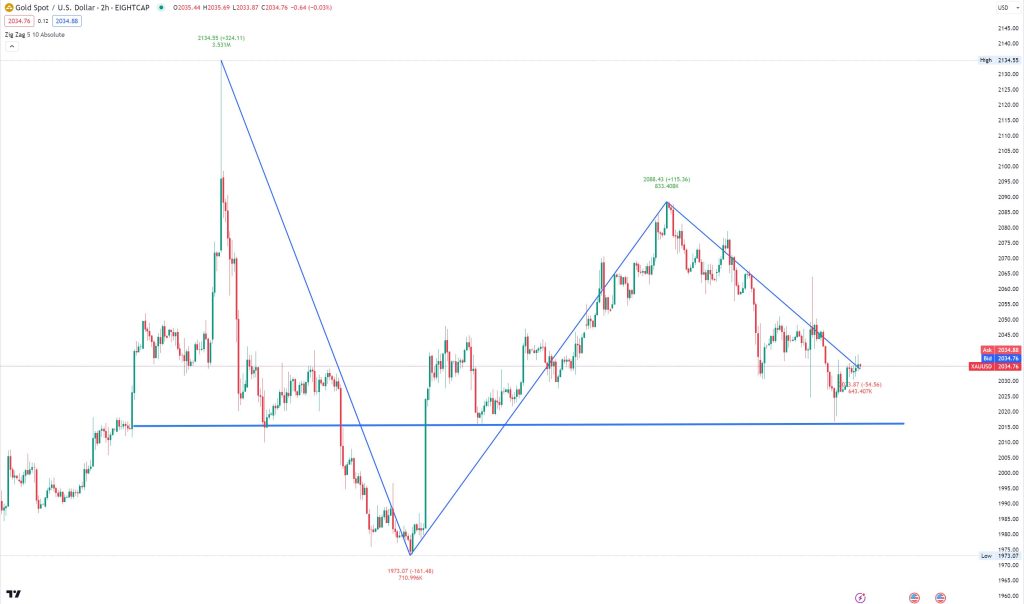
- This clear depiction of trend direction aids traders in aligning their positions with the broader market movement.
2. Spotting Reversal Points:
- One of the primary uses of the Zig Zag indicator is to identify potential reversal points in the market. When the indicator changes direction, it signifies a potential shift in the prevailing trend.
- Traders often wait for confirmation signals, such as a break in the trendline or additional technical indicators aligning with the Zig Zag’s reversal, before considering a trade entry or exit.
3. Confirmation Tool for Other Indicators:
- Traders frequently use the Zig Zag indicator in conjunction with other technical indicators. When multiple indicators corroborate a potential trend reversal or continuation, it strengthens the trading signal.
- Combining the Zig Zag indicator with oscillators like the Relative Strength Index (RSI) or Moving Average Convergence Divergence (MACD) can offer enhanced confirmation of trading opportunities.
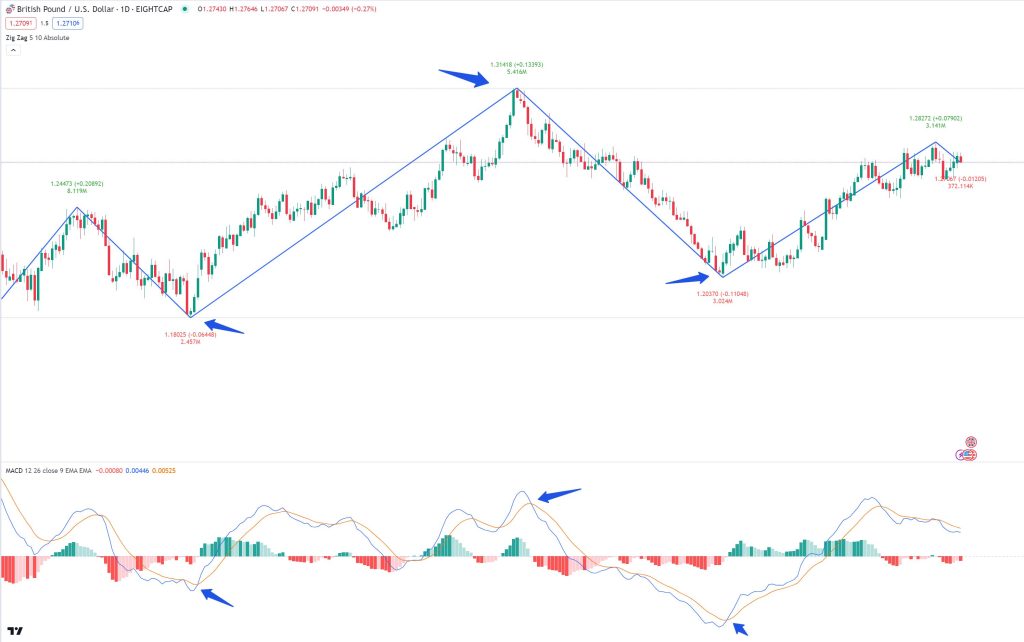
4. Setting Stop Loss and Take Profit Levels:
- Understanding the turning points highlighted by the Zig Zag indicator enables traders to set appropriate stop-loss and take-profit levels.
- Placing stop-loss orders beyond the last swing high or low and adjusting take-profit levels based on potential reversal zones can help manage risk and maximize profits.
5. Timeframe Considerations:
- The effectiveness of the Zig Zag indicator can vary across different timeframes. It’s crucial for traders to assess multiple timeframes to confirm trends and potential reversals.
- Higher timeframes (like daily or weekly) might provide a clearer view of long-term trends, while lower timeframes (such as hourly or 15-minute charts) might help in spotting shorter-term opportunities.
Strategies and Best Practices
Several trading strategies incorporate the Zig Zag indicator. Trend-following strategies involve using the indicator to ride a trend until signs of a potential reversal emerge. Additionally, traders leverage the Zig Zag indicator to identify divergences and locate crucial support and resistance levels.
Here are some common strategies and best practices:
1. Trend Following:
- Riding the Trend: Traders use the Zig Zag indicator to ride established trends until signs of a potential reversal emerge. They enter positions in the direction of the trend indicated by the Zig Zag’s pattern of higher highs and higher lows (or lower highs and lower lows in a downtrend).
- Confirmation with Other Indicators: Combining the Zig Zag with indicators like moving averages or trendlines can validate the strength of the prevailing trend.
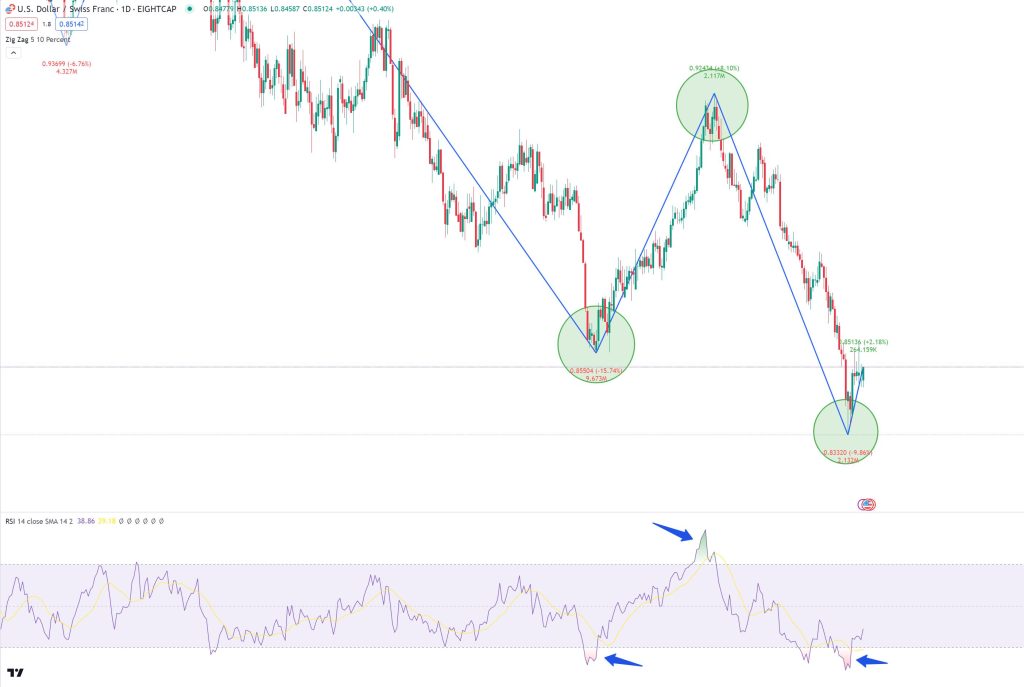
2. Divergence Analysis:
- Spotting Reversals: Traders look for divergences between price action and the Zig Zag indicator. A divergence occurs when the price forms a higher high or lower low, but the Zig Zag fails to mirror this movement.
- Confirmation Signals: Divergence between price and the Zig Zag might signal a potential trend reversal, especially when coupled with other technical indicators.
3. Support and Resistance Identification:
- Pinpointing Key Levels: The Zig Zag indicator assists traders in identifying significant support and resistance levels. Swing highs and swing lows highlighted by the indicator often coincide with crucial price levels.
- Trade Entry and Exit: Traders use these levels as potential entry or exit points, aligning their trading decisions with these support/resistance zones.
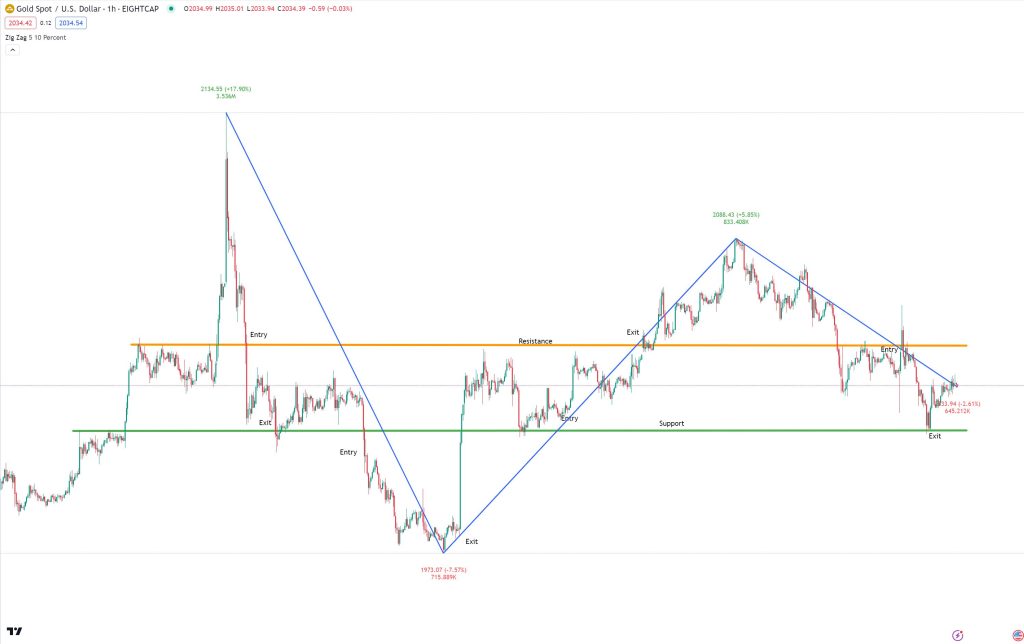
4. Adjusting Settings for Volatility:
- Adapting to Market Conditions: Traders adjust the settings of the Zig Zag indicator based on market volatility. During high volatility, reducing the parameters might help capture shorter-term trends, while increasing them in calmer markets might reveal more robust long-term trends.
5. Multiple Timeframe Analysis:
- Confirming Signals: Traders analyze multiple timeframes to confirm Zig Zag patterns across different scales. For instance, a trend reversal on a lower timeframe might align with a larger trend on a higher timeframe, strengthening the trading signal.
6. Using Zig Zag in Confluence with Other Indicators:
- Confirmation of Signals: Traders often combine the Zig Zag indicator with other technical tools, such as oscillators, moving averages, or Fibonacci retracements. This convergence of indicators can reinforce trading signals.
By integrating these strategies and best practices into their trading approach, traders can leverage the Zig Zag indicator effectively, enhancing their ability to identify trends, potential reversals, and significant price levels.
Pros and Cons
The Zig Zag indicator offers a simplified view of market trends, assisting traders in their decision-making process. However, its reliance on predetermined parameters might occasionally result in delayed responses to rapid market changes. Traders should remain mindful of this limitation while integrating the Zig Zag indicator into their analysis.
Pros:
1. Trend Clarity: The Zig Zag indicator excels in filtering out market noise, offering traders a clearer view of significant price movements and trend directions. This clarity assists in making informed trading decisions aligned with prevailing trends.
2. Simplicity: Its straightforward nature makes it accessible to traders of various skill levels. The indicator’s ability to identify swing highs and lows simplifies trend analysis and aids in spotting potential reversals.
3. Trend Confirmation: The Zig Zag indicator often corroborates trends observed on charts, reinforcing the confidence in trend identification. It serves as a useful tool for confirming trend directions seen through other technical indicators.
4. Customization: TradingView’s Zig Zag indicator allows customization, enabling traders to adjust settings based on market conditions and trading preferences. This flexibility enhances adaptability to different market scenarios.
Cons:
1. Lagging Indicator: As the Zig Zag indicator relies on predefined settings and past price action, it might lag behind real-time market movements. This delay could result in missed trading opportunities or delayed signals.
2. Sensitivity to Settings: The indicator’s effectiveness heavily relies on selecting appropriate parameters. In highly volatile markets, incorrect settings might produce excessive signals or overlook essential price movements.
3. Inflexibility in Certain Markets: During periods of low volatility or consolidation, the Zig Zag indicator might produce erratic or insignificant signals. It might struggle to provide valuable insights in such market conditions.
4. Signal False Positives: Like many technical indicators, the Zig Zag indicator is not infallible and might generate false signals, especially during choppy or sideways markets. Traders must exercise caution and consider additional confirmatory tools.
5. Limited Analysis: While the Zig Zag indicator aids in trend identification, it doesn’t provide detailed information about market conditions beyond trend direction. Traders might need to combine it with other indicators for comprehensive analysis.
Understanding these pros and cons helps traders utilize the Zig Zag indicator more effectively, acknowledging its strengths while being mindful of its limitations. Traders can mitigate drawbacks by combining it with complementary tools and conducting thorough analyses.
How to customize and enhance accuracy
When it comes to scalping, day trading, or intra-day trading, the Zig Zag indicator can be adapted and optimized to suit these shorter timeframes and rapid market movements. Here’s how you can customize and enhance its accuracy for these trading styles:
1. Adjusting Parameters:
- Reduced Percentage/Point Changes: For shorter timeframes, decrease the percentage or point changes in the Zig Zag settings. This adjustment allows the indicator to capture smaller price movements, crucial for scalping or intra-day trading.
- Lower Depth: Lower the depth parameter to capture shorter-term price swings. Scalpers and day traders aim to capitalize on quick moves, so reducing the depth can help in identifying these rapid shifts.
- Tighter Deviations: Consider using tighter deviations to make the Zig Zag indicator more sensitive to minor price fluctuations, which are essential for short-term trading strategies.
2. Combine with Shorter Timeframes:
- Use the Zig Zag indicator on shorter timeframes (such as 1-minute or 5-minute charts) to capture rapid price changes. This aligns with the shorter holding periods of scalping and day trading strategies.
3. Confirmation with Other Indicators:
- Combine the Zig Zag indicator with fast-moving oscillators like the Stochastic Oscillator or the Relative Strength Index (RSI). This can help confirm potential entry or exit points when they align with Zig Zag patterns.
4. Focus on High Liquidity Assets:
- Prioritize highly liquid assets or markets as they tend to exhibit clearer patterns and better adherence to technical indicators, enhancing the Zig Zag indicator’s accuracy in shorter timeframes.
5. Adapt to Volatility:
- Adjust the settings dynamically based on market volatility. In highly volatile market conditions, you might need to fine-tune the parameters to capture the rapid price movements characteristic of scalping or intra-day trading.
The Zig Zag indicator on TradingView proves to be an invaluable tool for traders seeking to navigate complex market movements. By filtering out noise and highlighting significant price changes, this indicator aids in the identification of trends and crucial turning points. Integrating the Zig Zag indicator into technical analysis strategies can significantly enhance a trader’s ability to interpret market behavior.
* The information provided here has been prepared by Eightcap’s team of analysts. All expressions of opinion are subject to change without notice. Any opinions made may be personal to the author and do not reflect the opinions of Eightcap.
In addition to the disclaimer on our website, the material on this page does not contain a record of our trading prices, or represent an offer or solicitation for a transaction in any financial instrument. Eightcap accepts no responsibility for any use that may be made of these comments and for any consequences that result. No representation or warranty is given as to the accuracy or completeness of this information. Consequently, any person acting on it does so entirely at their own risk. Any research provided does not have regard to the specific investment objectives, financial situation and needs of any specific person who may receive it. It has not been prepared in accordance with legal requirements designed to promote the independence of investment research and as such is considered to be a marketing communication.
Please note that past performance is not a guarantee or prediction of future performance. This communication must not be reproduced or further distributed without prior permission.


